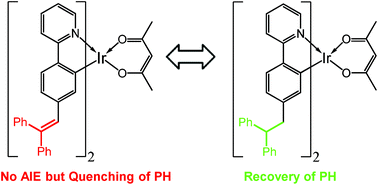No aggregation-induced-emission but quenching of phosphorescence for an iridium complex with a 2,2-diphenylvinyl motif: a joint experimental and theoretical study†
Abstract
The diphenylvinyl motif with rotary phenyl rings has been widely used as a building block for the construction of luminescent materials with aggregation-induced emission (AIE) properties. Here, we report the use of 2,2-diphenylvinyl in an iridium complex and its influence on the luminescence properties of the complex. Surprisingly, the 2,2-diphenylvinyl motif attached to the cyclometalating ligand brings about no AIE; instead, it completely quenches the phosphorescence from the iridium complex in solution or films at room temperature or at 77 K. Hydrogenation of the vinyl group in 2,2-diphenylvinyl recovers the phosphorescence. Theoretical calculations reveal that in the lowest triplet state of the complex, the 2,2-diphenylvinyl motif undergoes a significant structural change; as a result, the spin-density in the lowest triplet state distributes almost exclusively on the triphenylethene moiety of the cyclometalating ligand, with little distribution on the iridium ion, leading to complete quenching of phosphorescence. This work reveals that introduction of conjugated molecular motifs with rotational groups (such as 2,2-diphenylvinyl) into iridium complexes should be carefully treated, because it could quench the phosphorescence rather than inducing AIE, which provides a guideline for the design of AIE phosphors based on transition metal complexes.



 Please wait while we load your content...
Please wait while we load your content...